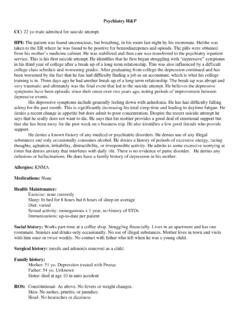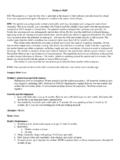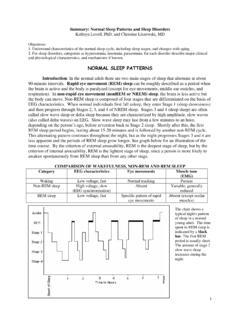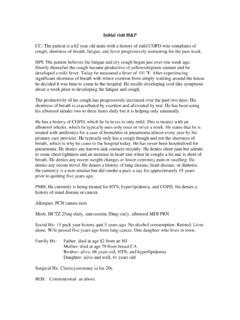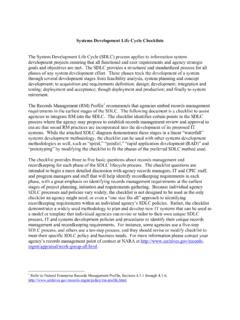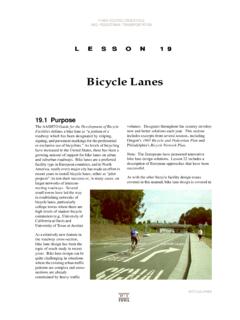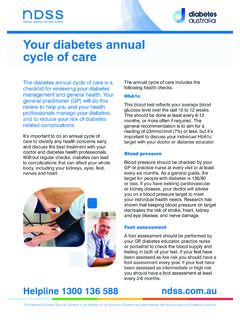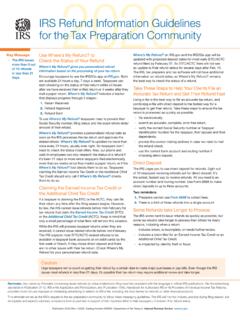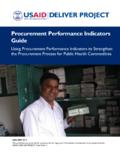Transcription of NORMAL SLEEP PATTERNS - learn.chm.msu.edu
1 1 Summary: NORMAL SLEEP PATTERNS and SLEEP Disorders Kathryn Lovell, PhD, and Christine Liszewski, MD Objectives: 1. Understand characteristics of the NORMAL SLEEP cycle , including SLEEP stages, and changes with aging. 2. For SLEEP disorders, categorize as hypersomnia, insomnia, parasomnia; for each disorder describe major clinical and physiological characteristics, and mechanisms if known. NORMAL SLEEP PATTERNS Introduction: In the NORMAL adult there are two main stages of SLEEP that alternate at about 90-minute intervals. Rapid eye movement (REM) SLEEP can be roughly described as a period when the brain is active and the body is paralyzed (except for eye movements, middle ear ossicles, and respiration). In non-rapid eye movement (nonREM or NREM) SLEEP , the brain is less active but the body can move. Non-REM SLEEP is composed of four stages that are differentiated on the basis of EEG characteristics.
2 When NORMAL individuals first fall asleep, they enter Stage 1 ( SLEEP drowsiness) and then progress through Stages 2, 3, and 4 of NREM SLEEP . Stages 3 and 4 (deep SLEEP ) are often called slow wave SLEEP or delta SLEEP because they are characterized by high amplitude, slow waves (also called delta waves) on EEG. Slow wave SLEEP may last from a few minutes to an hour, depending on the person s age, before reversion back to Stage 2 SLEEP . Shortly after this, the first REM SLEEP period begins, lasting about 15-20 minutes and is followed by another non-REM cycle . This alternating pattern continues throughout the night, but as the night progresses Stages 3 and 4 are less apparent and the periods of REM SLEEP grow longer. See graph below for an illustration of the time course. By the criterion of external arousability, REM is the deepest stage of SLEEP , but by the criterion of internal arousability, REM is the lightest stage of SLEEP , since a person is more likely to awaken spontaneously from REM SLEEP than from any other stage.
3 COMPARISON OF WAKEFULNESS, NON-REM AND REM SLEEP Category EEG characteristics Eye movements Muscle tone (EMG) Waking Low voltage, fast NORMAL tracking Present Non-REM SLEEP High voltage, slow (EEG synchronization) Absent Variable; generally reduced REM SLEEP Low voltage, fast Specific pattern of rapid eye movements Absent (except ocular muscles) The chart shows a typical night's pattern of SLEEP in a NORMAL young adult. The time spent in REM SLEEP is indicated by a black bar. The first REM period is usually short. The amount of stage 2 slow wave SLEEP increases during the night. 2 Development PATTERNS and changes with aging: One of the most significant determinants of a person s NORMAL SLEEP pattern is age. REM SLEEP occupies about 20-25% of the SLEEP time in NORMAL young adults. In humans the daily total SLEEP requirement declines steadily throughout childhood and adolescence, levels off during the middle years, and then often declines further with old age.
4 The need for REM SLEEP begins in utero. REM SLEEP fills approximately 80% of the total SLEEP time of infants born 10 weeks prematurely. In full-term neonates, REM SLEEP fills 50% of the SLEEP time. REM SLEEP declines sharply to about 30-35% of SLEEP time by age 2 and stabilizes at about 25% by 10 years of age. After that it shows little change until about age 65, when it further declines. The amount of stage 4 slow-wave SLEEP declines with age and in many people is nearly absent by age 70. As a consequence, older people spend proportionately more time in the lighter stages of slow-wave SLEEP , from which they awaken more often. Most adults in our culture learn to SLEEP in one extended period at night. However, the circadian rhythm of sleepiness is actually biphasic and NORMAL afternoon drowsiness is more pronounced in the elderly. The human SLEEP pattern changes with age.
5 Function of REM SLEEP : Most dreams occur during REM SLEEP . Deprivation of REM does not lead to serious psychological disturbance, as was once thought. The most important effect of REM deprivation is a dramatic shift in subsequent SLEEP PATTERNS when the subject is allowed to SLEEP without interruption. The longer the deprivation, the larger and longer the REM rebound, suggesting that REM SLEEP is physiologically necessary. However, the purpose of REM SLEEP or dreaming remains largely unexplained. There is activation of sensory systems during REM SLEEP . The visual system, particularly the superior colliculus circuit, is intensely activated, and all dreams have visual experiences. Neuroimaging studies of humans have also indicated activation of the limbic system, suggesting a biologic basis of activation of memories and emotions in REM SLEEP . Thus, the visual cortices and limbic areas to which they project may be operating as a closed system, functionally disconnected from frontal regions in which the highest order integration of visual information takes place.
6 Such cortical dysynchony could explain many of the experiential features of dreams, including heightened emotionality, uncritical acceptance of bizarre dream content, a dearth of parallel thoughts or images, temporal disorientation, and the absence of reflective awareness. Studies in animals indicated that those neurons that had been active during the day in encoding spatial position fired at a significantly higher rate in REM SLEEP than inactive neurons, suggesting that a general function of REM SLEEP is off-line processing of information acquired during the day. The atonia noted in REM SLEEP is under the control of the magnocellular nucleus of the medulla; this phenomenon is maintained via the reticulospinal tract which mediates inhibition of motor neurons. Neural mechanisms involved in the SLEEP -wake cycle : The body s SLEEP -wake cycle is usually under the control of circadian rhythms.
7 These rhythms are regulated by the 10620406080100 Totalsleeptime(hr/day)Age (years)302020406080100%stageREMAge (years)1503020406080100 Stage4(min/day)Age (years) 3 suprachiasmatic nucleus (SCN) of the hypothalamus. Incoming light which is transduced by retinal ganglion cells (melanopsin) is believed to be the primary factor synchronizing circadian rhythms. Several studies have found this process to occur via NMDA. Serotonin acts as a modulatory neurotransmitter; serotonergic input from the dorsal raphe nucleus in the midbrain periaqueductal gray area will act to inhibit the effects of light on the system and is associated with different aspects of the SLEEP wake cycle . There is minimal serotonergic input during REM SLEEP , and maximal input directly following REM. Thus these neurons may normally inhibit phasic REM events and their silence during REM SLEEP indicates a termination of this inhibition.
8 In contrast, many potential SLEEP -promoting factors have been identified, including muramyl peptides (found in bacterial cell walls), lipopolysaccharides, prostaglandins, interleukin-1, interferon-alpha2, tumor necrosis factor, delta SLEEP -inducing peptide, and vasoactive intestinal Besides enhancing SLEEP , all also exert effects on body temperature and on the immune response. One ancillary function of the SLEEP state may be to optimize the processes that counter infections. In the past few years it has been established that the cholinergic activating system, through projections to the thalamus, is important in EEG desynchronization characteristic of waking and REM SLEEP . REM-on neurons (selective activity during REM SLEEP ) in the brainstem use ACh as a neurotransmitter. Activity in this group of neurons recruits activity in effector neurons for REM SLEEP phenomena.
9 Most of the physiologic events of REM SLEEP have effector neurons location in the brainstem reticular formation, the pontine reticular formation (PRF). These neurons are important for the rapid eye movements ( generator for saccades is in PRF), and the muscle atonia of REM SLEEP . Many peptides ( substance P) are co-localized with ACh in brainstem neurons; they may modify responsiveness to ACh and may have independent actions. In addition, histamine-containing neurons are located in the posterior hypothalamus and are REM-off. The histamine system has been conceptualized as one of the wakefulness-promoting systems, in agreement with drowsiness as a common side effect of antihistamines. Orexin, a hypocretin that has been previously associated with feeding behaviors, has also been found to have a role is SLEEP behavior. Many areas of the brain associated with the SLEEP -wake cycle , specifically the lateral and dorsal hypothalamus, have orexin neurons and receptors.
10 Orexin A has been found to activate NE neurons in the locus coeruleus, which are believed to play a role in promoting wakefulness. SLEEP DISORDERS General concepts. About 15% of people living in industrialized countries have serious or chronic SLEEP problems. Basically there are three kinds of complaints regarding SLEEP : trouble staying awake (hypersomnia), trouble sleeping (insomnia), and abnormal sensations or behavior during SLEEP (parasomnias). These complaints often go together, people who have trouble sleeping may fail to get an adequate amount of NORMAL SLEEP and have difficulty staying awake the following day. Trouble staying awake and trouble sleeping may be referred to together as dyssomnias. Insomnia and hypersomnia may be symptoms in mood disorders, particularly depression. The most common disorders are (1) obstructive SLEEP apnea, (2) insomnia, (3) restless legs syndrome, (4) narcolepsy and idiopathic hypersomnia.
